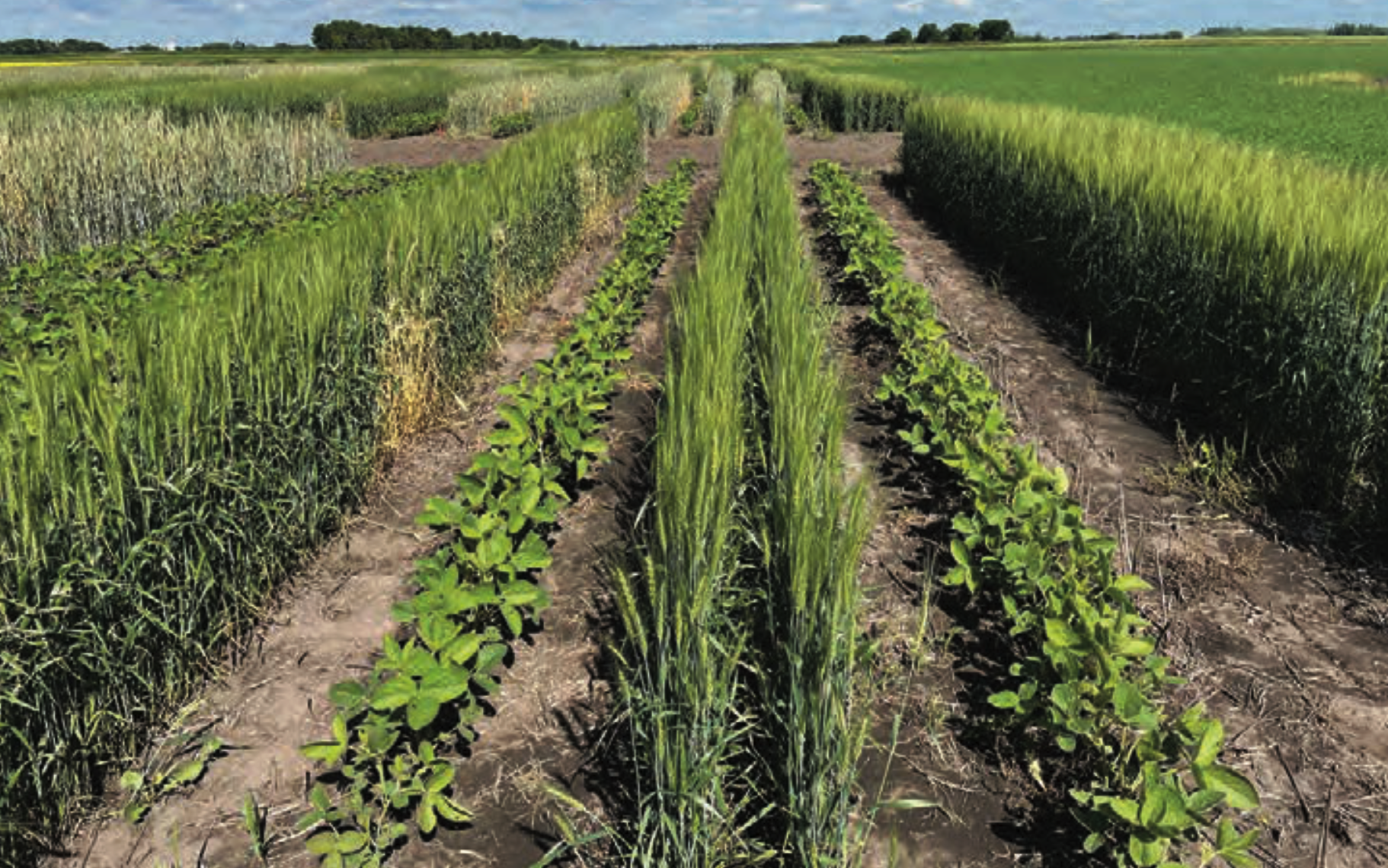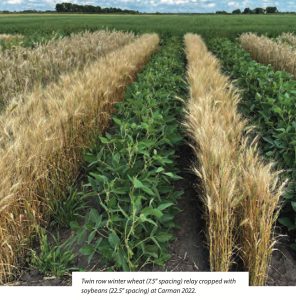Kristen P. MacMillan, MPSG Agronomist-in-Residence, University of Manitoba
Pulse Beat 96, Fall/Winter 2022
HARVESTING A SOYBEAN crop in the same year following harvest of a winter wheat or fall rye crop is one of the latest cropping systems to be evaluated in Manitoba. Termed “relay cropping”, the idea is to maximize growing season resources by seeding one crop, then seeding another crop and having their growing seasons overlap for a period. The first crop is harvested, and the second crop continues to grow until it is harvested. The winter wheat-soybean system has been popularized in Indiana and other parts of the mid-western US.. The concept of constant canopy cover and the potential for increased revenue have gained interest from farmers in the northern prairies. What would a relay crop system look like in Manitoba?
The soybean and pulse agronomy team has been experimenting with relay crop systems at Carman, MB since 2017. We’ve tested several crop combinations that include winter wheat, fall rye and winter camelina as the fall-seeded crops with soybeans, dry beans and peas as the spring relay crop sown directly into the established fall crop. The focus of this article will be the winter wheat- soybean relay crop system.
When evaluating alternative cropping systems, objective-based metrics should be identified. To most farmers, the primary objective is to maximize profitability, but secondary objectives, specifically when considering relay crop systems, may include over- yielding, increased soil cover and biodiversity, improvement in soil quality and risk mitigation. The metrics chosen to evaluate cropping systems in this study are Land Equivalent Ratio (LER) and Gross Margin (GM). LER is commonly used in multi-crop systems to compare how much land is required to produce the same amount of crop in monocrop vs. multi-crop systems. However, LER is inflated when monocrop yields are low, so considering multiple metrics is important.
AGRONOMY
Winter wheat was planted between September 18 and 21 using a drill or planter at 26-35 seeds/ft2. In the relay crop systems, the inter-row spacing was the same, which reduced the overall seeding rate by about half, depending on the spatial arrangement. In the relay crop system, we tested alternating rows of winter wheat and soybeans as well as twin rows where two rows of winter wheat (7.5” spacing) were planted and then three or five rows were skipped for a row of soybean (15” and 22.5” spacing). Fertilizer application included 60-100 lbs N/ac and 30 lbs P2O5/ac for both winter wheat and relay crop systems. Soybeans were planted between May 16 and 26 at 200,000 seeds/ac. Some variations of row spacing and seeding rates were also tested. In our trials, we hand-harvested the winter wheat, but specialized row guards are used on commercial combines to push down the soybeans. Combine tires must also align with the winter wheat rows to avoid damaging soybeans.
In-crop herbicide options are limited in the relay crop system – specifically, to a broadleaf herbicide (groups 4 + 6) application prior to soybean emergence. In some years, we applied a directed spray of glyphosate on the soybean rows, but this can damage the wheat. Using an RR2 Extend soybean variety would provide group 4 dicamba as an in-crop herbicide option but the application window is limited by the growth stage of the winter wheat. Alternatively, using a conventional soybean variety would reduce the seed input cost of the relay crop system.
RESULTS
Over five growing seasons, relay cropping winter wheat and soybeans have reduced productivity and profitability compared to growing either winter wheat or soybeans alone (Table 1). Neither crop was able to produce at least 50% of its monocrop yield in the relay crop system, thus the LER has been <1 and additional expenses have not been recovered. For the first four growing seasons (2018-2021), my hypothesis has been that moisture deficit is the limiting factor. So, in 2022, with near normal precipitation at Carman (but still below average), I expected to see the relay crop system shine. The relay crop system improved, but not nearly to the extent that the precipitation favoured soybeans, which surpassed all production systems. Thus, the ideal precipitation amount and pattern for successful relay cropping in Manitoba is unknown, and likely rare. Soybeans produced an impressive 66 bu/ac in 2022, beating out the winter wheat yield of 59 bu/ac and the relay crop system which produced 24 bu/ac of winter wheat and 24 bu/ac of soybeans. Thus, even under near-average moisture, the relay crop system did not improve productivity or profitability at Carman. Also of note is that seeding rate and row spacing rarely had an overall impact on relay crop yield or gross margin.
MOISTURE
Although this applied study did not attempt to explain the ecological principles of relay cropping, a lack of available soil moisture is likely the primary factor. Over the course of this study, growing season precipitation (May through August) has been between 175 and 265 mm (55-83% of normal). Growing season precipitation in Manitoba ranges from about 260 to 320 mm which is generally sufficient to produce most annual crops that use between 260 to 430 mm. Even with additional precipitation from the shoulder season (i.e., September and April), we still do not receive adequate rainfall to sustain two full-season cash crops in Manitoba, or elsewhere on the prairies. Areas where relay crop systems have been popularized have longer, warmer, and wetter growing seasons. Indiana, for example, receives about 550 mm of rain throughout the growing season.
VERDICT
Relay cropping winter wheat and soybeans has been a bust at Carman under dryland conditions over the past five years (2017-2022). Over- yielding has not occurred (LER <1) and profitability has been reduced (Table 1). In some years, gross margins have been comparable to the underperforming monocrop, but our gross margin calculation includes input cost only, and not the additional labour and fuel cost of a second seeding and harvest operation.
We have been studying this system during a five-year period of below- average precipitation. which has been 5 years in a row. At this point, winter wheat and fall rye are best utilized as cash crops alone. Winter cereals also serve well as fall seeded cover crops with the objective to reduce soil erosion and provide some weed suppression ahead of low-residue crops like soybeans and dry beans, with termination occurring at or before planting the cash crop. Attempting to harvest both for cash crops is a risky endeavour in our dryland region. Future work could test relay crop systems under irrigation, and one crop combination that warrants additional investigation is the winter cereal-yellow pea relay intercrop. Full details on our relay and intercropping studies will be available in the 2022 Annual Report this winter.



